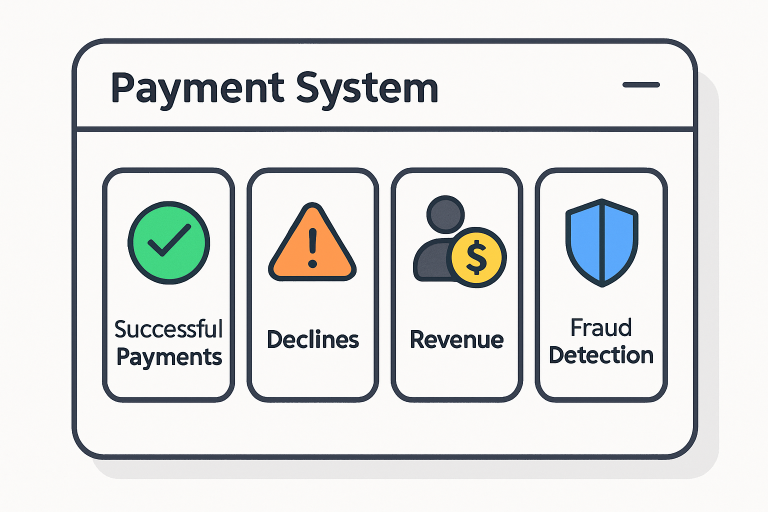Key Takeaways:
- A smooth and secure payment experience directly impacts player trust, satisfaction, and retention.
- Tracking key payment metrics allows developers to uncover hidden issues and optimize revenue performance.
- Real-time monitoring supports quick resolution of transaction errors and fraud risks.
- Data-driven insights from payment analytics empower studios to improve user experience and conversion rates.
- A well-optimized payment ecosystem helps sustain long-term growth and competitiveness in the gaming market.
Introduction
In today’s fast-paced gaming industry, providing a seamless, secure, and engaging purchasing experience is key to building player loyalty and growing revenue. The foundation of a successful game monetization strategy rests on a robust payment platform that processes transactions efficiently and ensures players feel confident and satisfied at every step. For developers and publishers, tracking metrics can reveal valuable insights and help fine-tune operations for peak performance. Leveraging modern payment solutions for gaming is essential for optimizing user journeys and minimizing friction in the payment process.
Regularly monitoring core metrics, your team can identify trends, resolve issues quickly, and proactively adapt to player needs. In a highly competitive environment, tracking payment system performance is not just about technical reliability—it’s a foundational aspect of player satisfaction and sustainable business growth. Understanding which indicators matter most provides a competitive advantage and equips you to maximize revenue while maintaining a stellar reputation among your player base.
Authorization Rate
The authorization rate refers to the percentage of payment transactions approved after players attempt them. In essence, it measures how successfully your game turns players’ intent to purchase into completed sales. High authorization rates suggest that your payment flows are working smoothly and that underlying systems, such as fraud controls and gateway configurations, are properly calibrated.
Conversely, a drop in authorization rate might indicate technical issues, gateway outages, or even unnecessary friction introduced by security checks. Consistently tracking authorization rates allows teams to pinpoint when and where players struggle to make purchases, enabling rapid troubleshooting and long-term improvements. According to Gamasutra, iterative adjustments based on real transaction data can significantly improve conversion rates and player satisfaction.
Decline Breakdown
Understanding why transactions are declined is crucial for reducing friction and frustration. A breakdown categorizes failed transactions by reason—for example, insufficient funds, expired cards, suspected fraud, network errors, etc. Tracking these categories over time reveals patterns that can signal systemic problems or temporary disruptions.
 For instance, if a decline uptick is traced back to payment gateway downtime, you can quickly escalate and resolve the issue. If many declines stem from suspected fraud, recalibrating your risk rules or investing in advanced fraud prevention solutions becomes a priority. This strategic approach means you aren’t simply chasing individual failed transactions but actively improving the overall health of your game’s payment system.
For instance, if a decline uptick is traced back to payment gateway downtime, you can quickly escalate and resolve the issue. If many declines stem from suspected fraud, recalibrating your risk rules or investing in advanced fraud prevention solutions becomes a priority. This strategic approach means you aren’t simply chasing individual failed transactions but actively improving the overall health of your game’s payment system.
Average Revenue Per User (ARPU)
Average Revenue Per User (ARPU) tracks the mean revenue generated per player within a given time frame, such as monthly or quarterly. This metric provides a clear snapshot of how successfully your monetization features perform and how engaged your players are. Monitoring ARPU enables you to assess the impact of new updates, event promotions, and in-game offers.
Optimizing ARPU is directly tied to your ability to scale revenue for games relying on in-app purchases or microtransactions. Improving ARPU typically involves offering more compelling content, better value bundles, exclusive access, or other rewards that encourage players to upgrade their purchases. Research from GWI suggests that experimenting with dynamic pricing and limited-time offers is a proven way to grow this metric sustainably.
Customer Lifetime Value (LTV)
Customer Lifetime Value (LTV) estimates the total revenue a player will generate across their entire engagement with your game. High LTV is a strong indicator of effective player retention and successful monetization. Calculating LTV requires a holistic understanding of spending habits, churn rates, and player longevity.
Elevating LTV means going beyond one-off purchases. Successful games leverage personalized offers, loyalty rewards, and regular content updates to maintain player interest and investment over time. Techniques like segmented marketing and seasonal promotions can keep players returning longer and spending more over their lifecycle.
Fraud Detection Rate
Fraud is a persistent risk that can erode revenue and damage player trust. The fraud detection rate tracks the number of suspicious or fraudulent transactions your system successfully identifies and blocks. Striking a balance is critical: missing too much fraud poses financial threats, while excessive false positives can frustrate genuine players and lead to lost sales.
Modern fraud management systems often incorporate machine learning, pattern analysis, and third-party verification tools to stay ahead of evolving attack vectors. Maintaining a high, accurate fraud detection rate protects your players and your business—establishing confidence in your payment system.
Chargeback Rate
Chargebacks occur when players dispute payments, often resulting in reversed transactions and potential fees for the game operator. A high chargeback rate leads to financial loss, strains your payment relationships, and impacts your reputation. Monitoring this metric closely helps you quickly identify the sources of disputes, whether due to unclear refund policies, accidental purchases, or allegations of unauthorized transactions.
To keep chargeback rates under control, it’s essential to maintain transparent purchase flows, provide responsive customer support, and implement effective fraud controls. Proactive communication and timely resolution of disputes help mitigate the negative impacts of chargebacks on your game’s bottom line.
Transaction Success Rate
The transaction success rate calculates the percentage of payments completed out of all attempts. It distills the combined effects of technical reliability, authorization processes, and user experience into a single, actionable number. A high transaction success rate signifies operational efficiency and a smooth player journey from intention to purchase.
To maintain this metric, teams should conduct regular system audits, resolve bottlenecks swiftly, and ensure payment partners are held to strong service level agreements. Periodic user testing can also uncover friction points or UX issues before they impact players at scale.
Customer Satisfaction (CSAT)
Customer Satisfaction (CSAT) directly measures how happy your players are with their payment experience. High CSAT scores reflect a frictionless, trustworthy, and user-friendly system—a key factor in boosting retention and fostering positive word-of-mouth. Collect player feedback after each transaction, and use these insights to refine the technical and service aspects of your payment system.
Responsive support, intuitive user interfaces, and transparent communication contribute to high CSAT. Consistently acting on feedback closes the loop and reassures your players that their experience is valued.
Final Thoughts
Monitoring and optimizing these key payment metrics empowers game developers to create rewarding, efficient, and secure transaction experiences. By tracking core indicators—authorization rate, decline reasons, ARPU, LTV, fraud and chargeback rates, transaction success, and CSAT—you comprehensively understand your payment system’s performance and player satisfaction. Smart use of data and ongoing optimization are essential for thriving in today’s competitive gaming market and ensuring enduring player engagement and revenue growth.

